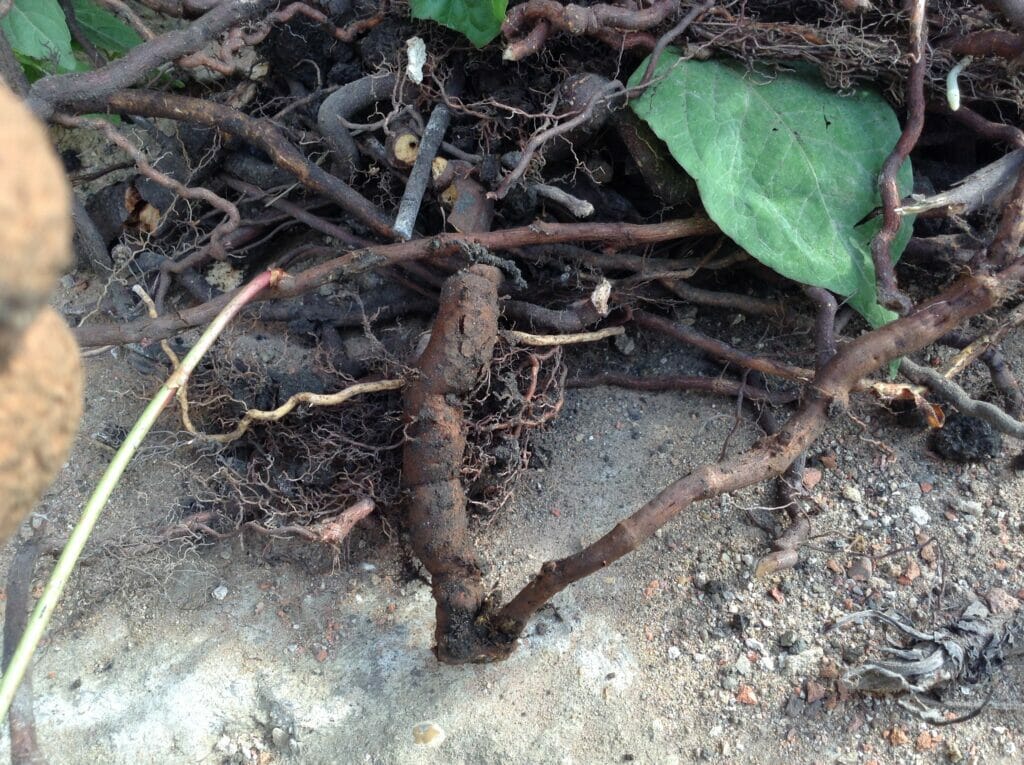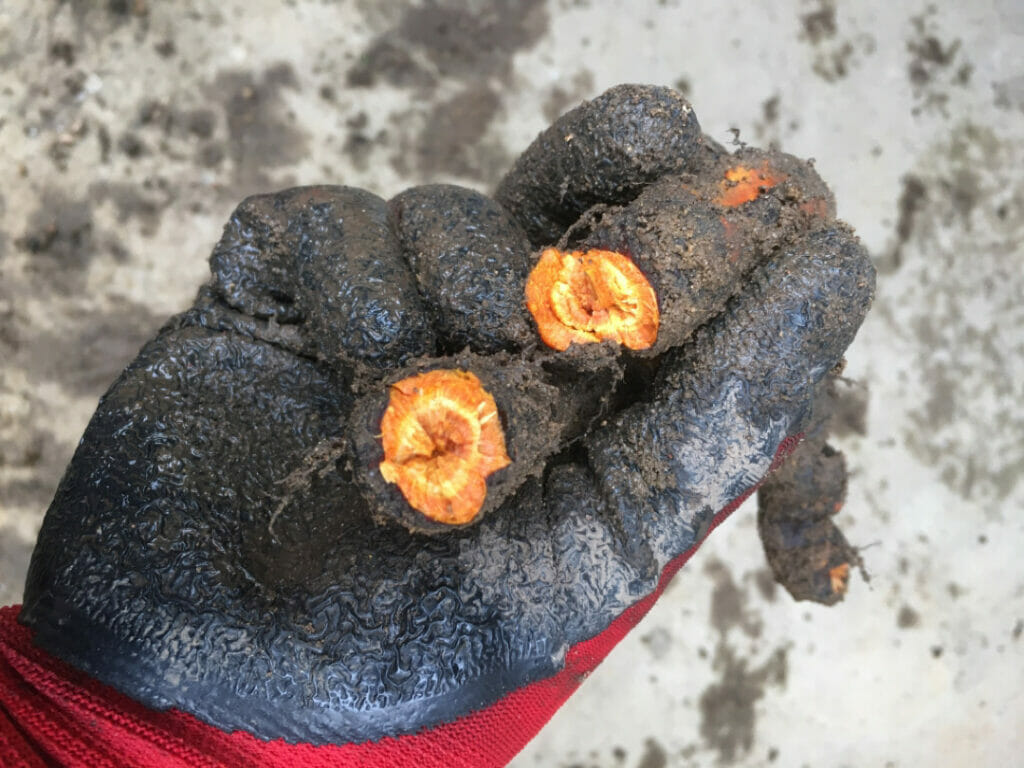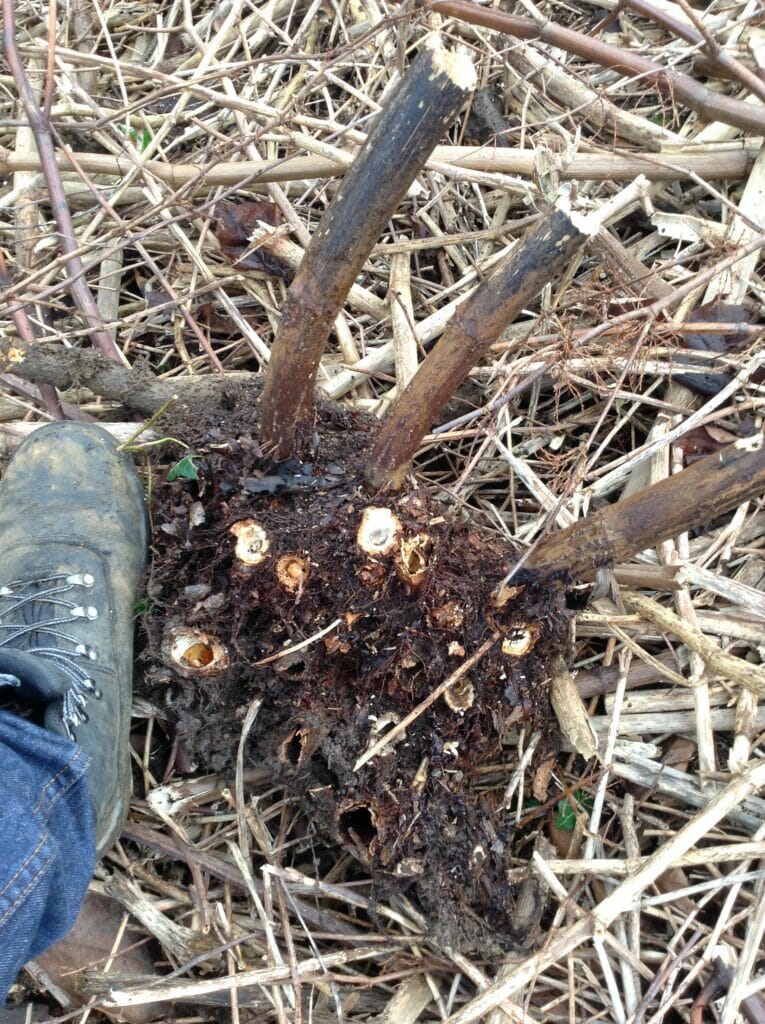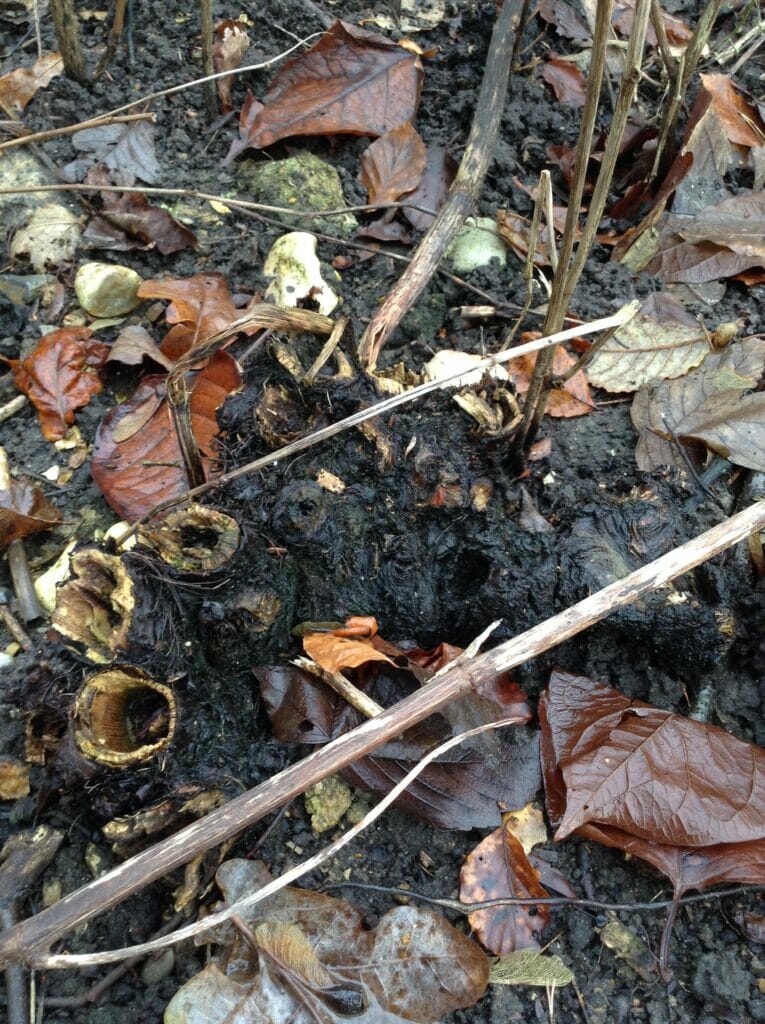Key to the eradication of Japanese knotweed is understanding why it is not the above ground parts of the plant that make it so tenacious and difficult to get rid of. In this blog post we will walk you through identifying the roots of Japanese knotweed, explain the difference between roots and rhizomes and explain what a rhizome is and why this part of the plant makes it so hard to eradicate. We will also take a look at the recent changes to Japanese knotweed guidance published by the Royal Institute of Chartered Surveyors (RICS) and how this might affect the methods of eradication.
Identifying Japanese knotweed roots
Japanese knotweed roots are comprised of two main parts. The rhizome and the fibrous roots. To be factually correct the rhizomes are actually not a root. They are often called roots because they are found underground but they are, in fact, modified stems. Understanding this is key to controlling Japanese knotweed. The roots (and upper-stems) grow from the rhizomes; it’s best to think of the plant in four parts: roots, rhizomes, upper stems and leaves (a simple guide to identifying the various parts of the plant can be found here: 5 easy ways to identify Japanese knotweed).
The true roots grow outwards from nodes along the rhizomes. They are small thin fibrous roots that are not very distinct from other roots that you will find in the soil. The rhizomes are much easier to identify.

Japanese knotweed rhizome with roots emerging (© 2023 PBA Solutions)
Knowing your rhizomes from your roots
The rhizomes of Japanese knotweed are quite distinctive. In the early stages of development, the rhizomes are thin white and fragile. With maturity they appear as a tough, woody, thick, brown subterranean stem. They have the appearance of a tree root but when broken (they can be snapped like a carrot) they have a distinctive orange colour in the interior.
Individually the rhizomes can be anything from 2mm-20mm thick. Japanese knotweed rhizomes are mostly found between 50cm-100cm deep in the soil, but where circumstances allow, can be found as deep as 3 metres. Over many years of growth, Japanese knotweed rhizomes can form dense crowns. From the nodes along the rhizome grow both the fibrous roots and upper stems. Understanding the relationship between the other parts of the plant and the rhizome is key to successfully eradicating Japanese Knotweed.
- A knotweed crown with a foot for scale (© 2023 PBA Solutions)
- Japanese knotweed crown with canes detached (© 2023 PBA Solutions)
Why Japanese knotweed rhizomes are the main concern
Rhizomes are key to the survival and spread of Japanese knotweed. They are the primary method by which the plant spreads and produces new plants. These underground stems store starches, proteins and nutrients that come from the upper stems and roots. They can lie dormant for many years in the soil and regenerate from fragments as small as 1cm. They are the powerhouse of the plant which is why any attempt at eradicating Japanese knotweed must focus on the rhizomes.
Killing or removing Japanese knotweed rhizomes will remove any possibility of Japanese knotweed regenerating. However, even the smallest amount of rhizome can lead to a new infestation. This is why it is vital to work with professional Japanese knotweed removal companies that offer insurance backed guarantees.
How to eradicate the roots and rhizomes
The immediate question for anyone that has discovered Japanese knotweed on their property will be: How do I eradicate Japanese knotweed rhizomes? In a previous blog we discuss the pros and cons of the remedies available: Japanese Knotweed Excavation vs Herbicide Treatment.

Snapped knotweed rhizome displaying its distinctive orange colour (© 2023 PBA Solutions)
There are two main options for dealing with Japanese knotweed rhizomes. Removal, herbicidal treatment (or a combination of both). Herbicidal treatment of Japanese knotweed alone is unlikely to lead to complete eradication. A long term study undertaken by Swansea university showed that although herbicide treatment was effective at controlling the spread of Japanese knotweed it did not effectively eradicate it. This is because not all of the herbicide was translocated to the rhizomes. The rhizomes could then remain dormant in the soil and regrowth could occur when conditions where right or the soil was disturbed.
This leaves mechanical removal as the most effective option. The rhizomes are physically removed from the soil and either removed from the site or re buried on site at a depth that will inhibit regeneration. This process is the more expensive but is the best option for complete eradication. A potentially cheaper option is to use a reduced level dig and then line the area with a root barrier such as Cutex. Clean material is then used to refill the site.
In reality, all Japanese knotweed solutions are likely to use a combination of these approaches, and the process used will always be site specific. Even if the intention is to remove or excavate the rhizome, herbicide treatment prior to removal can assist by making any remaining roots or rhizome less viable for future growth. This again highlights why it is vital to use professionals that will create a site-specific plan and provide an insurance backed guarantee.
The new RICS guidance and how this affects Japanese knotweed removal
The new RICS guidance note replaces the earlier 2012 paper ‘Japanese knotweed and residential property’. The guidance note seeks to lay out working standards and guidance for professionals that deal with the surveying and removal of Japanese knotweed. Whilst Japanese knotweed remains a vigorous invasive plant that has legal implications for property owners, the new guidance seeks to lessen some of the media hype around the damage that Japanese knotweed can cause to property. Building on industry knowledge and recent research some aspects of the earlier guidance have changed. Notably these are:
- It was previously believed that Japanese knotweed rhizomes could extend up to 7m from the main stems. This has now been reduced to 3m
- The maximum root depth has been downgraded from 5 m to 3m with an average depth of 1m
- The risk of Japanese knotweed causing significant structural damage has been downgraded.
These changes will allow for a more nuanced site-specific approach when dealing with Japanese knotweed infestations. The RICS guidance note states:
‘In each individual case the objective should be to implement the minimum acceptable interaction to achieve the desired affect at the least environmental cost.’
It should be noted that although the new guidance downgrades the risk to property it also states that ‘ignoring Japanese knotweed is not an acceptable strategy.’ Regardless of the reduced risk, Japanese knotweed legal cases continue to be brought, and the plant remains an environmental concern.
If you are worried that you may have discovered Japanese knotweed roots or rhizome, call 0203 174 2187 or 01202 816134 to talk to one of our consultants today.
Lead image © 2023 PBA Solutions



